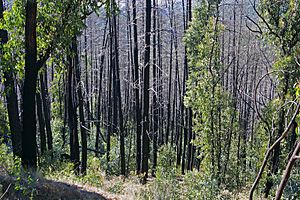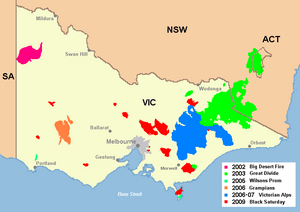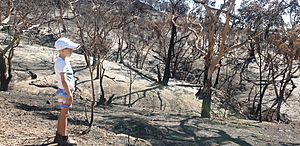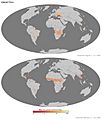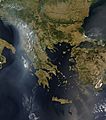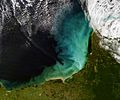Bushfires in Australia facts for kids
Bushfires in Australia happen often during the warmer parts of the year. This is because Australia has a mostly hot and dry climate. Every year, these fires burn huge areas.
On one hand, bushfires can destroy homes and cause people to lose their lives. On the other hand, some native Australian plants actually need bushfires to reproduce and grow. Fire has always been a natural and important part of Australia's environment. For thousands of years, Indigenous Australians used fire to help grow grasslands for hunting and to clear paths through thick plants.
Very big and dangerous fires that cause many deaths are often named after the day they happen. Examples include Ash Wednesday and Black Saturday. The most intense and deadly bushfires usually happen during droughts and heat waves. For example, the 2009 Black Saturday bushfires in Victoria killed 173 people. Other big fires include the 1983 Ash Wednesday fires and the 2003 Eastern Victorian alpine bushfires.
Global warming is making bushfires happen more often and become more severe.
Contents
What are Bushfires?
The word "bushfire" comes from "the bush", which means wild, less populated areas. In Australia, bushfires are usually defined as uncontrolled fires burning in grass, scrub, or forests. Australia has many different types of bushfires because its land and weather vary a lot. There are two main types, depending on the land's shape:
- Hilly/Mountainous Fires: These fires burn in hilly, mountainous, or alpine areas. These places are usually covered in thick forests. The land is hard to reach, so many of these forests are protected parks. Steep land makes fires spread faster and become more intense. If towns are in these areas, bushfires can be very dangerous to people and property.
- Flat/Grassland Fires: These fires burn on flat plains or slightly wavy areas, mostly covered in grass or scrubland. They can move very quickly, pushed by strong winds on flat ground. They burn up the small amount of plants very fast. These fires are usually less dangerous to towns. They rarely get as intense as major fires in hilly areas. Also, flat land is easier for firefighting teams to access and predict fire paths. Many flat areas in Australia have been cleared for farming, which means less fuel for fires.
Common causes of bushfires include:
- Lightning
- Sparks from power lines
- Arson (fires started on purpose)
- Accidental fires during farm work
- Grinding and welding activities
- Campfires
- Cigarettes and dropped matches
- Sparks from machines
- Fires that escape from controlled burns (fires set on purpose to reduce fuel)
How Bushfires Have Changed
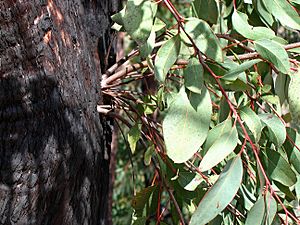
When humans first arrived in Australia, they changed how often natural fires happened. Fires became more frequent, and plants that love fire, like eucalypts, spread much wider. It's believed that early humans deliberately set fires to clear undergrowth or to help with hunting.
Australian plants have evolved many ways to survive (or even need) bushfires. Some have special buds that sprout after a fire. Others have seeds that only open when heated by fire. Some plants, like eucalypts, even encourage fire by having flammable oils in their leaves. This helps them get rid of other plants that can't handle fire as well.
Some native animals are also very good at surviving bushfires.
Bushfire Warnings
In 2009, all Australian states started using a standard Fire Danger Rating (FDR). During the fire season, the Bureau of Meteorology (BOM) provides fire weather forecasts. Fire agencies then use this information, including temperature, humidity, wind speed, and how dry plants are, to decide the Fire Danger Rating.
These ratings are shown in weather forecasts and tell people what to do to prepare. They are broadcast in newspapers, on radio, TV, and the internet.
| Category | Fire Danger Index |
|---|---|
| Catastrophic / Code Red | Forest 100+ Grass 150+ |
| Extreme | Forest 75–100 Grass 100–150 |
| Severe | Forest 50–75 Grass 50–100 |
| Very high | 25–50 |
| High | 12–25 |
| Low to moderate | 0–12 |
Managing Bushfires
The Australasian Fire Authorities Council (AFAC) is the main group that represents fire, emergency services, and land management agencies in Australia and New Zealand.
Queensland
The Rural Fire Service (RFS) is a volunteer firefighting group. It is part of the Queensland Fire and Emergency Services.
New South Wales
The New South Wales Rural Fire Service (RFS) is a volunteer firefighting group and a government body in New South Wales.
South Australia
The Country Fire Service is a volunteer fire service in South Australia. It is part of the South Australian Fire and Emergency Services Commission (SAFECOM).
Victoria
In Victoria, the Country Fire Authority (CFA) provides firefighting and other emergency services to country areas and regional towns. It also covers large parts of outer Melbourne that are not covered by the Metropolitan Fire Brigade.
Western Australia
The Department of Fire and Emergency Services of Western Australia (DFES) and the Department of Parks and Wildlife (P&W) share responsibility for managing bushfires in Western Australia. DFES supports many volunteer groups, including the Bush Fire Brigade volunteers and the Volunteer Fire Service.
Staying Safe During Bushfires
Local authorities teach people living in bushfire-prone areas about current fires. They also provide information on how to protect lives and property, and when it's safest to leave by car.
Bushfire Seasons
Bushfires can happen all year in Australia, but how severe they are and when the "bushfire season" is, changes by region. These seasons are often grouped by year, like the "2006-07 Australian bushfire season", and usually run from June one year to May the next.
In southeast Australia, bushfires are most common and severe during summer and autumn (December–March). They are especially bad in drought years and during El Niño events. Warm and dry conditions make fires much more likely.
In northern Australia, bushfires usually happen during the dry season (April to September). How severe they are depends more on seasonal weather patterns. In the southwest, fires also happen in the summer dry season. Fire frequency in the north is hard to measure because most fires are started by humans. However, lightning strikes are just as common a cause as human-started fires and arson.
Climate Change and Bushfires
Australia's weather has been getting more prone to bushfires over the last 30 years. The Climate Commission found that big bushfires in southeast Australia seem to be changing in how strong they are and when they happen. Climate change is likely a reason for this.
A 2006 report noted that much of Australia's plant life has a long history with fire. Fire has been part of these environments for tens of thousands of years, and many native plants and animals depend on it. In 2007, a study by the CSIRO (Australia's national science body) found that climate change will lead to more days with very high and extreme fire danger. It will also cause the fire season to start earlier. Other studies show big changes in Australia's bushfire season due to human activity.
Major Bushfires in Australia
Bushfires have caused over 800 deaths in Australia since 1851. In 2012, the total cost was estimated at $1.6 billion. However, in terms of money, they cause less damage than droughts, severe storms, hail, and cyclones. This is perhaps because they usually happen outside big cities. But the severe fires of the summer of 2019–2020 affected many populated areas, including holiday spots. The NSW Rural Fire Services Commissioner, Shane Fitzsimmons, said it was "absolutely" the worst bushfire season ever.
Here are some of the most severe Australian bushfires (single fires and fire seasons) in order:
| Date | Name or description | State(s) / territories |
Area burned (approx.) |
Fatalities | Properties damaged | Notes | |||
|---|---|---|---|---|---|---|---|---|---|
| ha | acres | Homes (destroyed) |
Other buildings | Other damage | |||||
| 6 February 1851 | Black Thursday bushfires | Victoria | 5,000,000 | 12,000,000 | approx. 12 | 0 | 0 |
|
|
| 9 September 1895 | Upper Blue Mountains fires | New South Wales | 150 | 370 | 0 | 24 | Sheds | Main Western Railway Line at Mount Victoria | |
| 1 February 1898 | Red Tuesday bushfires | Victoria | 260,000 | 640,000 | 12 | 0 | 2,000 | ||
| February – March 1926 | 1926 bushfires | Victoria | 390,000 | 960,000 | 60 | 1,000 | 0 | ||
| 13 January 1939 | Black Friday bushfires | Victoria | 2,000,000 | 4,900,000 | 71 | 3,700 | 0 | ||
| 14 January – 14 February 1944 | 1944 Victorian bushfires | Victoria | 1,000,000 | 2,500,000 | 15–20 | approx. 500 | 0 | ||
| 18 November 1944 | 1944 Blue Mountains bushfire | New South Wales | 0 | approx. 40 | 0 | ||||
| November 1951 – January 1952 | 1951–52 bushfires | Victoria | 4,000,000 | 9,900,000 | 11 | 0 | 0 | ||
| 2 January 1955 | Black Sunday bushfires | South Australia | 39,000–160,000 | 96,000–395,000 | 2 | 40 | 0 | ||
| 30 November 1957 | 1957 Grose Valley bushfire, Blue Mountains | New South Wales | 4 | 0 | 0 | ||||
| 2 December 1957 | 1957 Leura bushfire, Blue Mountains | New South Wales | 0 | 170 | 0 | ||||
| January – March 1961 | 1961 Western Australian bushfires | Western Australia | 1,800,000 | 4,400,000 | 0 | 160 | 0 | ||
| 14 – 16 January 1962 | 1962 Victorian bushfires | Victoria | 32 | 450 | 0 | ||||
| 16 February – 13 March 1965 | 1965 Gippsland bushfires | Victoria | 315,000 | 780,000 | 0 | more than 20 | 60 | 4,000 livestock | |
| 5 – 14 March 1965 | Southern Highlands bushfires | New South Wales | 251,000 | 620,000 | 3 | 59 | 0 | ||
| 7 February 1967 | Black Tuesday bushfires | Tasmania | 264,000 | 650,000 | 62 | 1,293 | 0 | ||
| 1968 – 69 | 1968-69 Killarney Top Springs bushfires | Northern Territory | 40,000,000 | 99,000,000 | 0 | 0 | 0 | ||
| 29 November 1968 | 1968 Blue Mountains Bushfire | New South Wales | 4 | approx. 120 | 0 | ||||
| 8 January 1969 | 1969 bushfires | Victoria | 23 | 230 | 0 | ||||
| 1969 – 70 | 1969-70 Dry River-Victoria River fire | Northern Territory | 45,000,000 | 110,000,000 | 0 | 0 | 0 | ||
| 1974 – 1975 summer fire season (defined as October 1974 to February 1975 in Queensland only) |
1974-75 Australian bushfire season |
|
117,000,000 | 290,000,000 | 6 | unknown | unknown | 15% of Australia was burnt. The damage was mostly in central Australia and so it did not impact many communities.
|
|
| 12 February 1977 | Western Districts bushfires | Victoria | 103,000 | 250,000 | 4 | 116 | 340 | ||
| 17 December 1977 | Blue Mountains Fires 1977 | New South Wales | 54,000 | 130,000 | 2 | 49 | 0 | ||
| 4 April 1978 | 1978 Western Australian bushfires | Western Australia | 114,000 | 280,000 | 2 | 0 | 6 | ||
| December 1979 | 1979 Sydney bushfires | New South Wales | 5 | 28 | 0 | ||||
| 3 November 1980 | 1980 Waterfall bushfire | New South Wales | 1,000,000 | 2,500,000 | 5 | 14 | 0 | ||
| 9 January 1983 | Grays Point bushfire | New South Wales | 3 | 0 | 0 | ||||
| 16 February 1983 | Ash Wednesday bushfires |
|
418,000 | 1,030,000 | 75 | approx. 2,400 | 0 | ||
| 25 December 1984 | 1984 Western New South Wales grasslands bushfires | New South Wales | 500,000 | 1,200,000 | 0 | 0 | 0 |
|
|
| Mid-January 1985 | 1985 Cobar bushfire | New South Wales | 516,000 | 1,280,000 | 0 | ||||
| 1984 – 1985 season | 1984 - 85 New South Wales bushfires | New South Wales | 3,500,000 | 8,600,000 | 5 | ||||
| 14 January 1985 | Central Victoria bushfires | Victoria | 50,800 | 126,000 | 3 | 180 | 0 | ||
| 27 December 1993 – 16 January 1994 | 1994 Eastern seaboard fires | New South Wales | 400,000 | 990,000 | 4 | 225 | 0 | ||
| 8 January 1997 | Wooroloo bushfire | Western Australia | 10,500 | 26,000 | 0 | 16 | 0 | ||
| 21 January 1997 | Dandenongs bushfire | Victoria | 400 | 990 | 3 | 41 | 0 | ||
| 2 December 1997 | Lithgow bushfire | New South Wales | 2 | 0 | 0 | ||||
| 2 December 1997 | Menai bushfire | New South Wales | 1 | 11 | 0 | ||||
| 2 December 1997 | Perth and South-West Region bushfires | Western Australia | 23,000 | 57,000 | 2 | 1 | 0 | ||
| 2 December 1998 | Linton bushfire | Victoria | 5 | 0 | 0 | ||||
| 25 December 2001 – 7 January 2002 | Black Christmas bushfires | New South Wales | 753,314 | 1,861,480 | 0 | 121 | 0 | ||
| August – November 2002 | 2002 NT bushfires | Northern Territory | 38,000,000 | 94,000,000 | 0 | 0 | 0 | ||
| 19 October 2002 | Thurlgona Road Bushfire | New South Wales | 0 | 10 | Numerous Sheds | ||||
| 20 October 2002 | Abernathy Bushfire | New South Wales | 1,400 | 3,459 | 1 | 13 | Numerous Sheds | ||
| 4 December 2002 | 2002 NSW Bushfires | New South Wales | 1 | 20 | Significant damage to Holsworthy Army Base | ||||
| 18 – 22 January 2003 | 2003 Canberra bushfires | Australian Capital Territory | 160,000 | 400,000 | 4 | approx. 500 | 0 | ||
| 8 January – 8 March 2003 | 2003 Eastern Victorian alpine bushfires | Victoria | 1,300,000 | 3,200,000 | 0 | 41 | 213 | 10,000 livestock | |
| December 2003 | Tenterden | Western Australia | 15,000 | 37,000 | 0 | 2 | 0 | ||
| 10 – 12 January 2005 | 2005 Eyre Peninsula bushfire | South Australia | 77,964 | 192,650 | 9 | 93 | 0 | ||
| New Years Day 2006 | Jail Break Inn Fire, Junee | New South Wales | 30,000 | 74,000 | 0 | 7 | 4 |
|
|
| December 2005 – January 2006 | 2005 Victorian bushfires | Victoria | 160,000 | 400,000 | 4 | 57 | 359 | 65,000 livestock | |
| January 2006 | Grampians bushfire | Victoria | 184,000 | 450,000 | 2 | 0 | 0 | ||
| 6 February 2006 | Pulletop bushfire, Wagga Wagga | New South Wales | 9,000 | 22,000 | 0 | 0 | 2 |
|
|
| 1 December 2006 – March 2007 | The Great Divides bushfire | Victoria | 1,048,000 | 2,590,000 | 1 | 51 | 0 | ||
| September 2006 – January 2007 | 2006–07 Australian bushfire season |
|
1,360,000 | 3,400,000 | 5 | 83 | approx. 20 | ||
| 4 February 2007 | Dwellingup bushfire | Western Australia | 12,000 | 30,000 | 0 | 16 | 0 | ||
| 6 – 14 December 2007 | 2007 Kangaroo Island bushfires | South Australia | 95,000 | 230,000 | 1 | 0 | 0 | ||
| 30 December 2007 | Boorabbin National Park | Western Australia | 40,000 | 99,000 | 3 | 0 | 0 |
|
|
| 7 February – 14 March 2009 | Black Saturday bushfires | Victoria | 450,000 | 1,100,000 | 173 | 2,029 | 2,000 | ||
| 4 January 2013 | Tasmanian bushfires | Tasmania | 20,000 | 49,000 | 1 | ||||
| 18 January 2013 | Warrumbungle bushfire | New South Wales | 54,000 | 130,000 | 0 | 53 | 118 |
|
|
| 17 – 28 October 2013 | 2013 New South Wales bushfires | New South Wales | 100,000 | 250,000 | 1 | 208 | 40 | ||
| 27 December 2011 – 3 February 2012 | Carnarvon bushfire complex | Western Australia | 800,000 | 2,000,000 | 0 | 0 | 0 | 11 pastoral stations (fences, watering systems, water points, stock feed) |
|
| 2 – 9 January 2015 | 2015 Sampson Flat bushfires | South Australia | 20,000 | 49,000 | 0 | 27 | 140 | ||
| 29 January – 20 February 2015 | 2015 O'Sullivan bushfire (Northcliffe – Windy Harbour) | Western Australia | 98,923 | 244,440 | 0 | 2 | 5 | Thousands of hectares of production forests (karri and jarrah) or national parks | |
| January 2015 | 2015 Lower Hotham bushfire (Boddington) | Western Australia | 52,373 | 129,420 | 0 | 1 | 1 |
|
|
| 1–9 August 2015 | 2015 Wentworthfalls Winter Fire | New South Wales | 800 | 2,000 | 0 | 0 | 0 | ||
| October – November 2015 | 2015 Esperance bushfires | Western Australia | 200,000 | 490,000 | 4 | 10 | 0 |
|
|
| 15 – 24 November 2015 | Perth Hills bushfire complex – Solus Group | Western Australia | 10,016 | 24,750 | 0 | 0 | 0 | Jarrah production forest and Conservation Park | |
| 25 November – 2 December 2015 | 2015 Pinery bushfire | South Australia | 85,000 | 210,000 | 2 | 91 | 0 | ||
| January 2016 | 2016 Murray Road bushfire (Waroona and Harvey) | Western Australia | 69,165 | 170,910 | 2 | 181 | Yarloop Workshops |
|
|
| 11 – 14 February 2017 | 2017 New South Wales bushfires | New South Wales | 52,000 | 130,000 | 0 | 35 | 0 | ||
| Early February 2019 | Tingha bushfire | New South Wales | 23,419 | 57,870 | 0 | 19 | |||
| 5 September 2019 – 2 March 2020 | 2019–20 Australian bushfire season (Black Summer) | Nationwide | 18,626,000 | 46,030,000 | 34 | approx. 2,600 | approx. 6,000 | At least one billion wild animals are estimated to have died (not including frogs and insects) with some species thought to be facing extinction. | Area Other |
| 1 June 2020 – 1 June 2021 | 2020–21 Australian bushfire season | Nationwide | 250,000 | 617,763 | 0 | 85 | Dozen outbuildings and 1 Service Station in Lucindale and dozens of out buildings in Bradbury.
Outbuildings, sheds and a nursery destroyed in Oakford. Outbuildings lost in Wooroloo and surrounds. |
1 house in Northmead north west of Sydney was severely damaged. | |
Related pages
Images for kids
-
Smoke from bushfires can cover a large area. This is eastern Victoria.
-
The city of Melbourne covered in smoke during the 2006-2007 bushfire season.
-
An Australian bustard searching for food behind a bushfire.
-
Ladysmith NSW RFS fire fighting tanker
-
Wildfire near Yosemite National Park, United States, in 2013. The Rim Fire burned more than 250,000 acres (1,000 km2) of forest.
-
A surface fire in the western desert of Utah, United States
-
Charred landscape following a crown fire in the North Cascades, United States
-
Experimental fire in Canada
-
A dirt road acted as a fire barrier in South Africa. The effects of the barrier can clearly be seen on the unburnt (left) and burnt (right) sides of the road.
-
Lightning-sparked wildfires are frequent occurrences during the dry summer season in Nevada.
-
Ecological succession after a wildfire in a boreal pine forest next to Hara Bog, Lahemaa National Park, Estonia. The pictures were taken one and two years after the fire.
-
A Pyrocumulus cloud produced by a wildfire in Yellowstone National Park
-
National map of groundwater and soil moisture in the United States. It shows the very low soil moisture associated with the 2011 fire season in Texas.
-
A prescribed burn in a Pinus nigra stand in Portugal
-
Dry Mountain Fire Lookout in the Ochoco National Forest, Oregon, circa 1930
-
Wildfires across the Balkans in late July 2007 (MODIS image)
-
Wildland firefighter working a brush fire in Hopkinton, New Hampshire
-
Charred shrubland in suburban Sydney (2019–20 Australian bushfires).
-
Smoke from the 2020 California wildfires settles over San Francisco
-
Elk Bath, an award winning photograph of elk avoiding a wildfire in Montana
-
Aerial view of deliberate wildfires on the Khun Tan Range, Thailand. These fires are lit by local farmers every year to promote the growth of a certain mushroom
See also
 In Spanish: Incendios forestales de Australia para niños
In Spanish: Incendios forestales de Australia para niños


